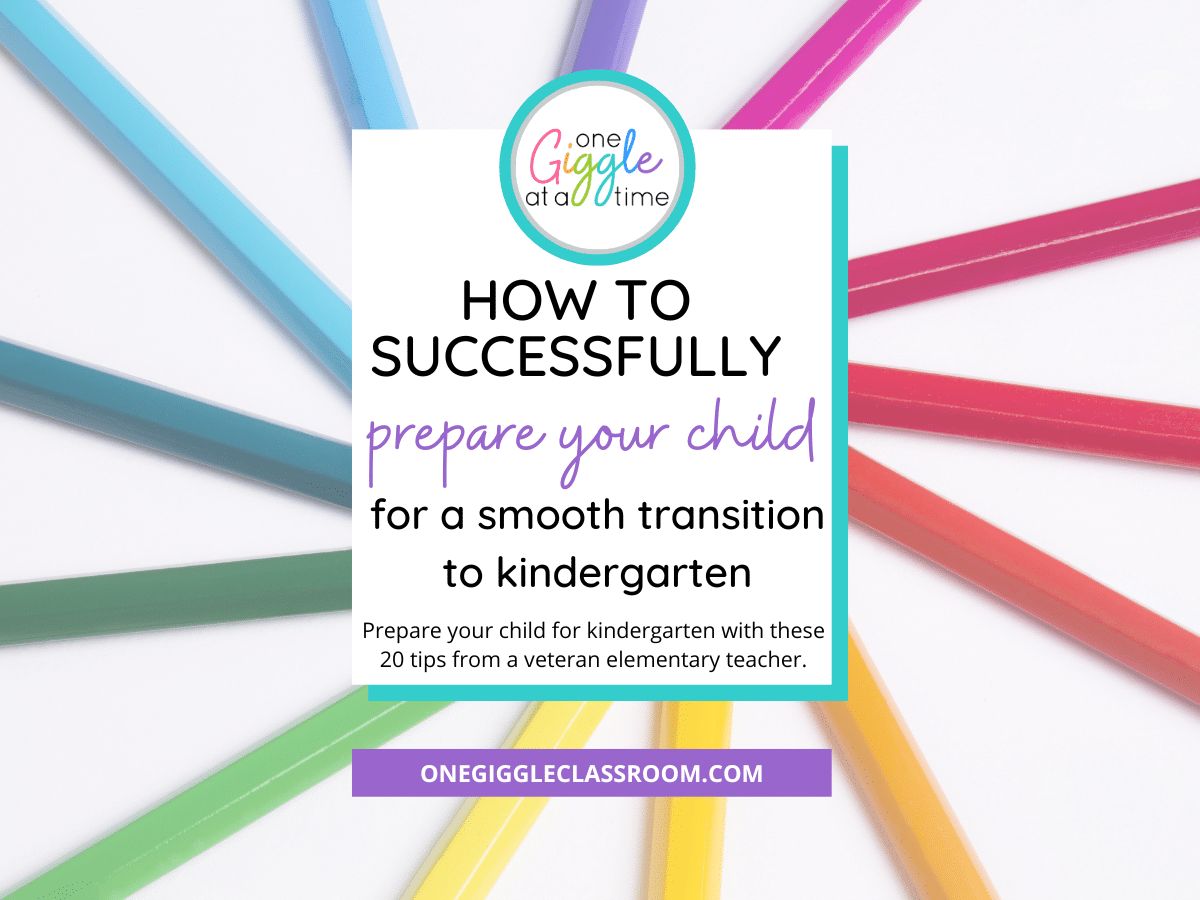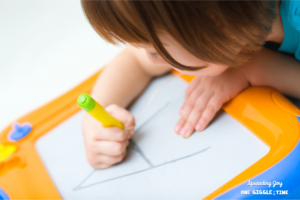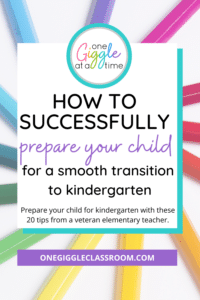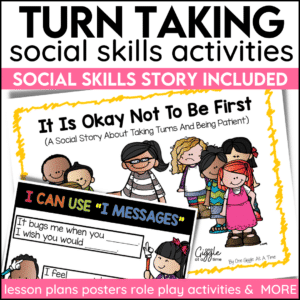
How To Successfully Prepare Your Child For A Smooth Transition To Kindergarten
Share This:

Does the idea of your child starting kindergarten leave your family feeling anxious? Check out a great book, a super fun activity, and tips on preparing your child for a smooth transition to kindergarten!
THE TRANSITION TO KINDERGARTEN BRINGS OUT ALL THE EMOTIONS!
It is safe to say that apart from senior year in high school, kindergarten is the year of schooling that brings out all the feels for everyone involved:
- Parents get emotional because their baby is growing up…kindergarten is a rite of passage after all
- The child experiences big feelings because they are embarking on a world of the unknown full of big people and big responsibilities
- Everyone in that child’s circle is feeling all the feels because if time is moving on for this child, then it only stands to reason that time is moving on for them too, and where could time have possibly gone?
EVERY SINGLE one of those feelings is valid and real, for every single person involved. Going to kindergarten IS IN FACT a big deal, but you and your little one can be prepared as you enter into this season of change together!
START WITH THE PERFECT BOOK!

This topic is near and dear to my heart. My sons are now grown, but the memory of sending them to kindergarten is still so vivid in my mind that it could have happened yesterday.
I also spent 30 wonderful years teaching first grade. So I have seen my fair share of First Days of kindergarten, and consequently what comes afterward once all the excitement of that initial day of wonder has come and gone.
Those two things were huge factors in my decision to write a book all about getting ready for the amazing adventure that is kindergarten!
A PICTURE BOOK TO PREPARE CHILDREN FOR KINDERGARTEN
The Going to Kindergarten Book for Kids is a fun and encouraging picture book that follows four kindergarten students as they explore their first day of school. This story shows young readers not only what to expect, but how exciting it is to be a kindergartener!
The Going to Kindergarten Book for Kids …
- Inspires an open mind. The story encourages kids to be brave and embrace new adventures as they follow kindergartners Mya, Frankie, Stella, and Jose on their first day.
- Takes a positive attitude. This book keeps things light with scenarios that are encouraging and silly—without anything that might prompt nerves or fear.
- Explains the entire day. Reassure kids with a story of what their whole day will look like; from getting up and dressed to arriving at school, eating lunch, and coming home again.
WHAT OTHERS ARE SAYING ABOUT THIS BOOK
I highly recommend this book for any child heading to kindergarten. But don’t just take my word for it! Here is what some of the experts had to say…
“Diane Romo has written the perfect book to spark excitement about those first few days of kindergarten. The illustrations and carefully written words give children an idea of what to expect and what they can look forward to. This sweet story should be added to every teacher’s and parent’s bookshelves! Highly recommend!” —Hilary Statum, teacher, author, and Pencils to Pigtails Blogger
“The perfect book for any kindergartener! Unlike other books about the first day of school, every page shows what really happens on the first day of school in kindergarten classrooms. This book will help kids be excited and prepared for their new adventure!” —Emily Yerty, educator, curriculum designer, and author
A CRAFT & ACTIVITY PAGES FOR KINDER-BOUND KIDS
To go along with the Going to Kindergarten Book for Kids, I created the perfect craft and activity pages for children who are about to begin this thrilling adventure! …and it’s FREE!

In the story, Mya and Frankie can be seen making a craft that turns out to be a school bus. Your little one can make their own school bus, and also take some time with you to explore his/her feelings and expectations about going to kindergarten.
Activity pages include:
- how I am feeling about going to kindergarten
- what I hope to do at kindergarten
- what I wonder about kindergarten
- what I want to learn at kindergarten
- a keepsake page to place a photo of your child on the first day of kindergarten
This is not only a great way to share some time together exploring big emotions about this new adventure, but it gives your child a great opportunity to practice important skills needed for kindergarten, such as:
- cutting
- writing
- coloring
- gluing
- following directions
20 TIPS FOR PREPARING YOUR CHILD TO TRANSITION TO KINDERGARTEN
I also have some great tips for getting your child ready for kindergarten. As I mentioned, I spent 30 years teaching first grade. If I know anything for sure, it is that children who come to school with some sense of preparation are definitely at an advantage.
They are at an advantage academically, they are at an advantage socially, and they are at an advantage emotionally.
Let’s dive into 20 simple ways you can help your little one start that kindergarten journey with a positive advantage!
1. START FOSTERING INDEPENDENCE
Now is the time to begin making sure your little one is able to do some things independently.
When they are toddlers, it is so often just easier and quicker to do the “little things” for them rather than endure the time, stress, and potential mess of them doing things themselves. But the truth is, if they have never had to do anything independently before they arrive at kindergarten, they are going to quickly find themselves at a disadvantage. They are not going to be the only one in that classroom, bus, or cafeteria. There won’t always be an adult immediately available to attend to their every need.
Teach them how to:
- put on, zip, and button a coat
- hang up a coat
- zip and unzip their backpack
- open their lunchbox
- open food containers that will be common during school lunch and breakfast (this includes milk cartons, juice boxes, juice pouches, fruit cups, yogurt, cheese sticks, snack bags, thermos, etc.)
- carry a tray with items on it (they will be carrying their own lunch tray at school)
- carry their own backpack
- tie their shoes (if they cannot master this, consider slip-on shoes when buying school shoes)
Along the same lines, if you can teach your child patience and how to take turns, their experience in kindergarten will go more smoothly.
The Taking Turns Social Skills Activity Pack includes printables and activities for teaching turn-taking and patience.
2. READ TO YOUR CHILD BEFORE THEY TRANSITION TO KINDERGARTEN
There is so much value in reading to your child. Children who are frequently read to:
- have better listening skills
- have a better understanding of the written word
- have a stronger imagination
- develop a better understanding of the world around them
- develop stronger language skills
3. TALK NUMBERS BEFORE THE TRANSITION TO KINDERGARTEN

It is important to build your child’s sense of numbers before they transition to kindergarten. You can easily do this by engaging in the following simple activities:
- count with your child (count objects around the room, count cars driving by, count the number of toys they can pick up in a minute…the possibilities are endless! And don’t just stop at 10 or 20. If they can count higher…let them count higher!)
- write numbers
- read numbers
- trace numbers in the air
- organize things into groups of numbers (organize toy cars into groups of 4, organize dolls into groups of 3)
4. MAKE YOUR CHILD AWARE OF ENVIRONMENTAL PRINT
Nothing builds confidence in a child like when they become aware of environmental print!
Environmental print is the print of everyday life– the logos, signs, and labels that we see all around us and are able to recognize immediately.
Make a habit to point out environmental print around you during your daily outings and activities. Talk about the letters. Talk about the words. Have your child “read” the signs and labels to you. It is important that kids begin to become aware of print in their world.
5. PRACTICE LETTER IDENTIFICATION BEFORE THE TRANSITION TO KINDERGARTEN

Just as it is important to build your child’s sense of numbers before they enter kindergarten, it is also important to build their sense of letters and sounds. You can easily do this by engaging in the following simple activities:
- write letters with your child (introduce them to uppercase and lowercase)
- read ABC books to your child
- play with magnetic letters
- sing songs about the alphabet
- match letter sounds with pictures
- play games with letter cards
- point out the letters in your child’s name or the letters you have been working on in your environment as you go about your daily activities together
6. GET YOUR CHILD MOVING BEFORE THEY TRANSITION TO KINDERGARTEN
Kindergarten is a busy place, and that doesn’t even include phys ed time, walking in the hallways, and all the fun to be had on the playground!
It is important that your child is able to move around independently and confidently. Make sure they get lots of practice with:
- walking safely when in a large group of people
- running
- jumping
- skipping
- climbing stairs
- navigating playground equipment (if possible, visit the school playground before kindergarten begins so your child can practice using the equipment). It is important that you supervise your child’s playground visit, however, so that you ensure that your child is learning the “proper and safe” way of using the playground equipment
7. PRACTICE CUTTING WITH SCISSORS BEFORE THE TRANSITION TO KINDERGARTEN
Teach your child how to properly hold child-safe scissors and how to use them before they make the transition to kindergarten.
If your child favors his/her left hand, then left-handed scissors are the best option for him or her. It is very helpful if you are able to find this out before kindergarten begins, that way you will be able to share this information with the teacher and avoid frustration for your child when it is time for cutting activities.
8. PRACTICE WRITING AND COLORING

Writing and coloring are an integral part of kindergarten, and so you want your child to be comfortable with these activities as well.
Teach your child how to hold a pencil to write, and how to hold crayons to draw and color.
Give them lots of opportunities to practice these skills. This will not only build their confidence and skill in these areas, but it will make them stronger and give them more stamina for these kindergarten activities by building the necessary muscles in their hands.
9. FOSTER TURN-TAKING BEFORE THE TRANSITION TO KINDERGARTEN
When thinking about your child’s big transition to kindergarten, fostering turn-taking is just as important as fostering independence and for many of the same reasons.
There are going to be lots of situations in which your child will need to wait for his or her turn… to be served a snack, to get assistance from the teacher, to speak during a lesson, to use certain supplies, or to play with certain toys… and that is just the tip of the iceberg.
If your child is already used to waiting for his or her turn now and then, it will cut down on frustration and impatience once kindergarten begins.
10. TEACH NAME RECOGNITION AND PRINTING
In kindergarten, your child will be expected to recognize his or her name printed in lots of different places:
- at his or her seat
- on supplies
- at his or her cubby or locker
- and on his or her papers
It is also helpful if your child is already beginning to print his or her name. So provide plenty of opportunities for them to practice printing their name.
A great place to start is by writing your child’s name in large capital letters and having your child trace those letters as they say the name of the letters aloud. Trace at first with their finger, then later with a crayon, and after they have good control of the crayon, you can move on to tracing with a pencil. Once they have mastered tracing the letters, move on to copying the letters they see, and then eventually writing their name independently.
11. MASTER SELF-CARE SKILLS BEFORE TRANSITIONING TO KINDERGARTEN
So, toileting and bathroom self-care are obviously necessary for your child to master when transitioning to kindergarten. But there are a few other self-care skills that should also be practiced before going to school for the first time. Make sure to teach your child the basic skills of:
- using tissues- (wiping their nose when it is running, using a tissue instead of “picking,” blowing their nose when it is stuffy)
- using a napkin to wipe their mouth
- covering their sneeze
- covering their cough
- washing their hands
- cleaning up their space after eating
12. PROVIDE OPPORTUNITIES FOR SOCIALIZATION BEFORE TRANSITIONING TO KINDERGARTEN
Give your child opportunities to play and interact with other children the same age.
The park, the neighborhood, the playground, and the library are all great places for your child to get comfortable with the idea of interacting with other children.
This is also a great time to introduce the concept of personal space. Learn how to successfully teach your child how to respect others’s personal space here.
13. MAKE MANNERS A PRIORITY BEFORE THE TRANSITION TO KINDERGARTEN
Begin working on manners now so the transition to kindergarten won’t be such a shock!

Learning manner will help your child interact more comfortably and effectively with his or her peers. Work on things like:
- saying “please” and “thank you”
- when it is good manners to say “Excuse me”
- chewing with their mouth closed
- using proper utensils to eat
- using kind words
- being a good sport
This Personal Space Social Skills Activity Pack is a great resource to use both in the classroom and at home to help kids learn about personal space and maintaining boundaries before they transition to kindergarten.
14. WORK ON COMMUNICATION SKILLS
Good communication skills will also help your child interact more comfortably and effectively with his or her peers. Work on things such as:
- using words to express their feelings
- making eye contact when speaking with someone
- responding when being spoken to
- listening without interrupting
15. PRACTICE FOLLOWING DIRECTIONS
Knowing how to follow directions is a must in kindergarten! Help their transition to kindergarten go more smoothly by practicing at home now.
When you give your child directions, break them down into one or two steps at a time, and make sure your child actually follows through with those directions.
Too many directions at one time (multi-step directions) are difficult for children to process. Fun ways to practice following directions are playing games like the following:
- Simon Says
- Red Light Green Light
- Hokey Pokey
- board games and card games
Here’s a great article from Understood.org with tips to help your child follow directions.
16. ESTABLISH ROUTINES
Young children thrive on routines, and kindergarten is a very structured place when it comes to routines and schedules.
Some of the main routines that you can begin to prepare your child for include:
- A longer day of activity- If your child is still napping during the day, you are going to want to start to stretch out the activities during the daytime hours to get him or her used to the upcoming school schedule
- Transitions- There will be lots of transitions during the school day. Practice making smooth transitions from one activity to the next by establishing and acknowledging the end of one event and the start of another. (“We are done playing with the puzzles now, let’s put those away. We are going to have lunch.”)
- Remaining in “one place” to complete an activity- Kindergarten is full of MOVEMENT, and kindergarteners are not expected to be still. It’s still important for you to start practicing with your child on their ability to stay in “one place” to complete activities such as listening to a story or coloring or playing with playdoh, rather than wandering around the room or around the house while doing those things.
17. GIVE THEM OWNERSHIP OF SCHOOL SUPPLIES

When you purchase those new supplies for your child, make sure you give them time to become familiar with their new tools– how they work, the proper way to use them, and how to store them.
Giving a kindergartener brand new unopened packages of school supplies and sending them to school usually ends up with those supplies being lost, ruined, or used up by the end of the first day.
Here’s a short list of things to practice:
- how to use a glue stick
- how to put the lid back on a glue stick
- how to erase
- how to put the crayons back in the box
- how to use scissors
- how to put papers in a folder
- how to open and close their lunchbox
- how to open and close their backpack
- how to use their backpack
18. GIVE THEM SOME SPACE
Separation anxiety is real and it can hit hard when kindergarten starts. There are many adjustments to be made, and it can be overwhelming for a child sometimes.
If you haven’t spent much time away from your child, begin to schedule some outings if possible, so that your child experiences being away from you for short periods of time.
He or she needs to get used to the fact that when you are apart for a while, it is okay because you will always be returning and be back together again.
19. GET THEM TALKING ABOUT THEIR FEELINGS
Start conversations about how they are feeling about going to kindergarten. Some will feel excited, nervous, scared–or maybe all of the above!

By getting them to talk about their emotions, you can them through any big feelings they are having while they consider their transition to kindergarten. The Going to Kindergarten Craft and Activity is a perfect way to do this! Just fill out the form above to get your craft and activity today!
20. TALK ABOUT WHAT A TYPICAL DAY WILL LOOK LIKE
Talk about what they can expect in a typical school day! This is a great way to prepare your child for the start of kindergarten.
Things are so much less scary and overwhelming when we have some prior knowledge of what to expect.
The Going to Kindergarten Book for Kids does that perfectly!
How lucky your child is that you are taking the time to prepare him or her for this exciting adventure of transitioning to kindergarten! Enjoy every bit of it; it’s such a special time!
Want to find this post again? Pin it!

Other posts you may enjoy:
Top 10 Activities for Teaching Feelings in the Elementary Classroom
7 Successful Strategies For Teaching Respect Of Personal Space To Kids
KEEP THE HOME-SCHOOL CONNECTION OPEN WITH THESE
Free Positive Notes Home
The perfect way to build a strong working relationship with the families of your students!


Diane Romo
Thank you for being here! I love sharing ideas with other teachers! If you are looking to enhance your teaching and build a positive classroom community, you have come to the right place!














